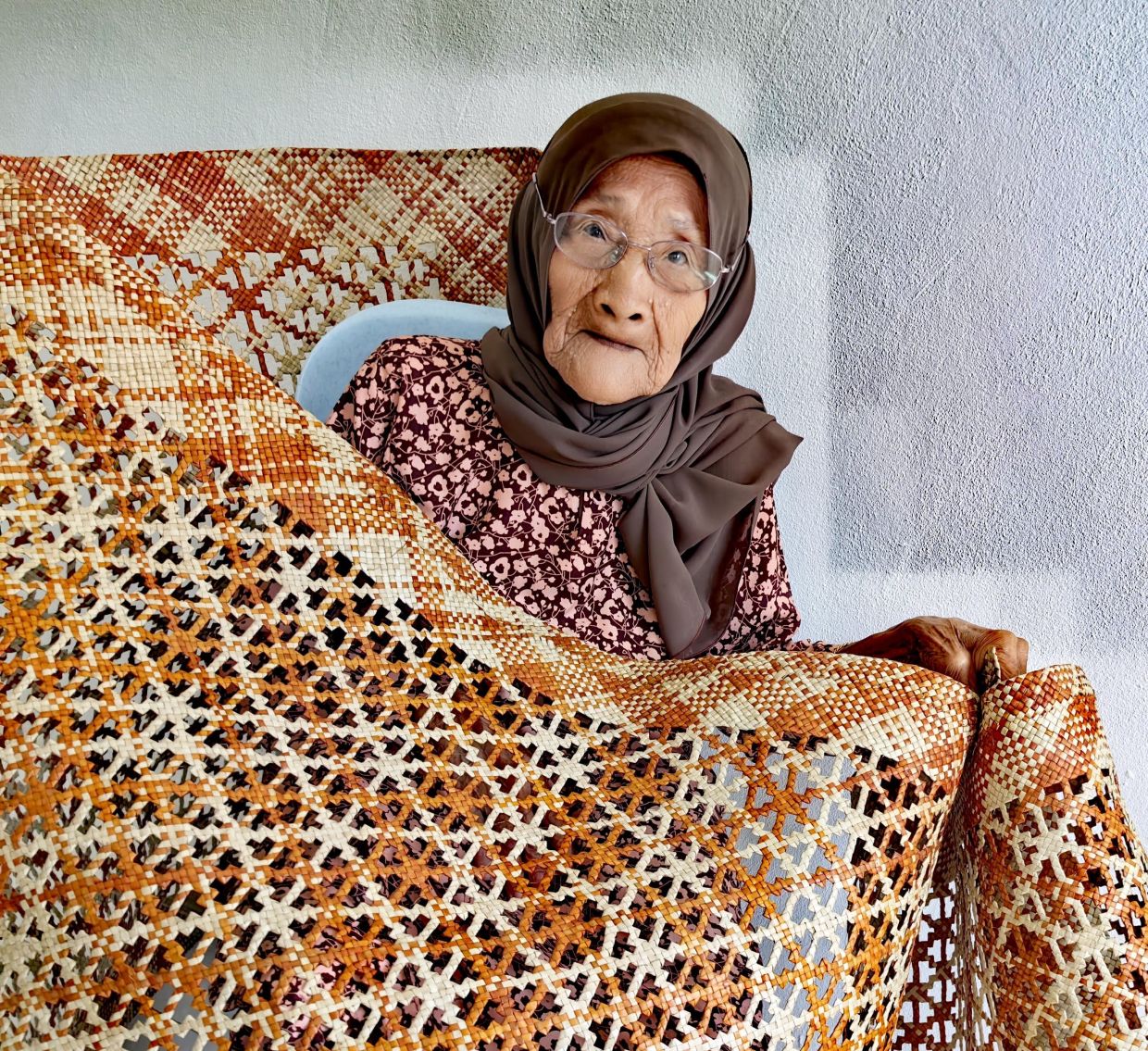'I continue to weave because my heart tells me to weave,' says Ngot. Photos: Edric Ong
Ngot Bi, is 91 years old and is one of the most revered senior citizens in Kampung Semera Ulu Sadong Jaya, Asa Jaya, Sarawak where she lives. She is among the few remaining traditional mat weavers in the state and boasts over 80 years of experience in the craft, making her the go-to person for handcrafted mats in the community.
“When I was younger, I learned weaving in my village. I practised slowly, day and night. Over time, I became skilled in weaving,” she says.
“I continue to weave because my heart tells me to weave. But I’m old and I tire easily. It’s a difficult process to weave these mats. Often, my body aches after hours of weaving. But I continue to do it as I enjoy weaving. Slowly but surely, I can finish my handcrafted mats,” said Ngot in a video produced by Yayasan Hasanah.
Although Ngot is skilled in weaving techniques like twinning (a technique employed to make baskets) and interlacing (used to make mats with traditional motifs), she’s carved a name for herself as one of the the last few pandan bergerang (lattice plaited pandanus leaves) mat weavers in Sarawak.
Ngot has earned the reputation as being one of the last few pandan bergerang mat weavers in Sarawak. In September, she was accorded the title of Best Traditional Weaving (Plaiting) at Yayasan Hasanah’s Hasanah Gold Thread awards, an event celebrating excellence and innovation in Malaysian heritage textiles and techniques.
“It took me three months to complete the winning piece. This is because there are many floral patterns on the mat,” explained Ngot, who learned the art from an elderly weaver from Betong, Sarawak in 1999.
The award is one of several honours the mother of seven has received throughout the years as a skilled weaver.
In 2005, the grandmother of eight earned the Seal Of Excellence for Handicraft Products in Southeast Asia award from Unesco. Nine years later (2014), she earned the title Adiguru Kraf Anyaman (Master Weaver Craftswoman) by Kraftangan Malaysia.
Weaving her tradition
Pandan bergerang weaving, a heritage of the Malay community in Saribas, Sarawak, involves intricate layered mat weaving of squares that represent motifs inspired by traditional beliefs.
The handwoven mats serve various purposes within the Malay community: They are used for prayers, weddings, as welcoming gifts for firstborns, and during wedding ceremonies.
Some Orang Asli communities in Peninsular Malaysia use the lattice weaving technique to make headbands, bags and bookmarks.
The meticulous process begins with selecting and cutting pandanus leaves to the same size, flattening them with a tool called “jangat”, boiling them and then straightening, soaking, and sun-drying the leaves.
Ngot says the completion times for her products varies and can take up to a year for larger sized mats. Smaller projects take about a month. The primary challenge is ensuring uniformity in the weave.
“Weaving is not only challenging but also requires patience. Specific challenges faced include discrepancies in the size of the motifs, in which case I have to undo the work and reweave.”
Ngot worries about the future of this traditional weaving technique.
She recognises the dedication needed to master the craft which makes it less than appealing among youngsters in this fast-paced world.
“I tried to teach my children and grandkids but sadly, they are not interested in this craft. Many people aren’t interested in this craft because it’s time-consuming and the earnings aren’t much,” says the great-grandmother of one.
Despite this, she’s hopeful that the younger generation will take an interest and appreciate the beauty of the weaving process.
“In the future, I hope more organisations will organise workshops to encourage the younger generation to be interested in this craft of tikar bergerang.”
Still going on strong
'I continue to weave because my heart tells me to weave,' says Ngot. Photos: Edric Ong
Ngot (second from right) received her award for Best Traditional Weaving (Plaiting) at Hasanah Gold Thread Awards from Women, Family and Community Development Minister Datuk Seri Nancy Shukri. Photo: Tanoti
— TANOTI
Lattice plaited mengkuang mats handcrafted by Ngot.
- EDRIC ONG
Ngot is a passionate mat weaver with over 80 years experience under her belt.
— EDRIC ONG










